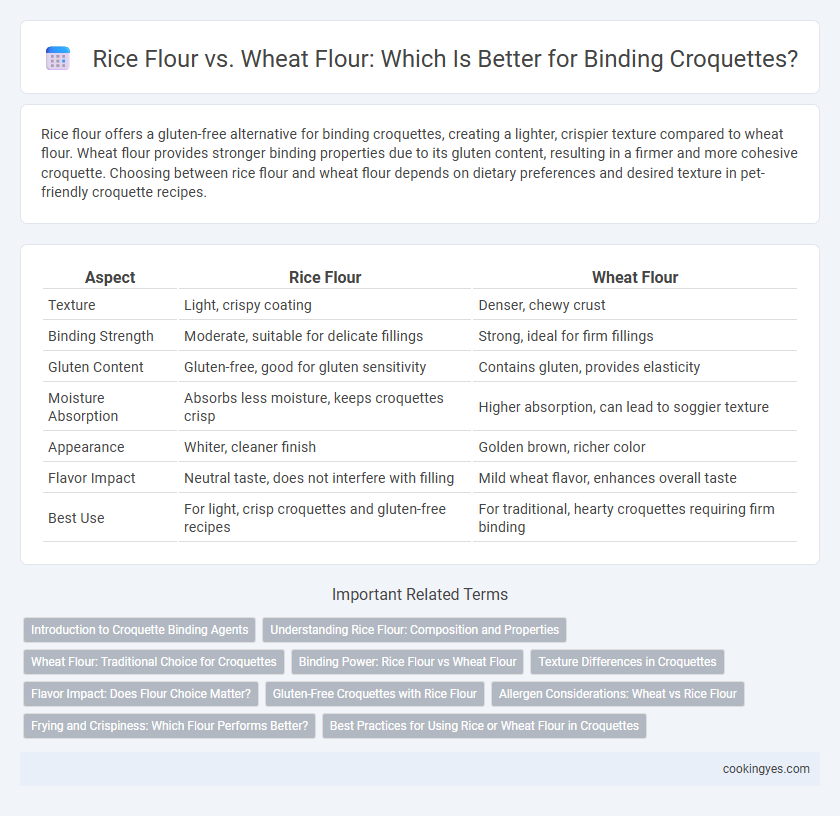Rice flour offers a gluten-free alternative for binding croquettes, creating a lighter, crispier texture compared to wheat flour. Wheat flour provides stronger binding properties due to its gluten content, resulting in a firmer and more cohesive croquette. Choosing between rice flour and wheat flour depends on dietary preferences and desired texture in pet-friendly croquette recipes.
Table of Comparison
| Aspect | Rice Flour | Wheat Flour |
|---|---|---|
| Texture | Light, crispy coating | Denser, chewy crust |
| Binding Strength | Moderate, suitable for delicate fillings | Strong, ideal for firm fillings |
| Gluten Content | Gluten-free, good for gluten sensitivity | Contains gluten, provides elasticity |
| Moisture Absorption | Absorbs less moisture, keeps croquettes crisp | Higher absorption, can lead to soggier texture |
| Appearance | Whiter, cleaner finish | Golden brown, richer color |
| Flavor Impact | Neutral taste, does not interfere with filling | Mild wheat flavor, enhances overall taste |
| Best Use | For light, crisp croquettes and gluten-free recipes | For traditional, hearty croquettes requiring firm binding |
Introduction to Croquette Binding Agents
Rice flour and wheat flour serve as common binding agents in croquette preparation, each influencing texture and crispiness differently. Rice flour offers a lighter, crispier coating with excellent moisture retention, ideal for achieving a delicate crunch, while wheat flour provides a denser, more elastic bind that enhances structural integrity. Choosing between these flours depends on the desired croquette consistency and the specific culinary application, impacting the overall mouthfeel and frying performance.
Understanding Rice Flour: Composition and Properties
Rice flour, composed mainly of starch with minimal protein, offers a lighter and crispier texture for croquettes compared to wheat flour, which contains gluten that provides elasticity and chewiness. Its fine granules absorb less oil during frying, contributing to a delicate, non-greasy crust ideal for achieving a crunchy exterior without heaviness. The absence of gluten in rice flour makes it suitable for gluten-free croquette recipes, ensuring a tender bite while maintaining structural integrity during cooking.
Wheat Flour: Traditional Choice for Croquettes
Wheat flour serves as a traditional binding agent in croquettes due to its high gluten content, which provides a firm and elastic texture essential for holding fillings together during frying. Its ability to create a cohesive dough ensures even crispiness while maintaining structural integrity, a characteristic preferred in classic croquette recipes. Compared to rice flour, wheat flour contributes a richer flavor and a more satisfying bite, making it the staple choice for authentic croquette preparation.
Binding Power: Rice Flour vs Wheat Flour
Rice flour provides a lighter, crispier texture with moderate binding power, making it suitable for delicate croquettes that require a gentle hold. Wheat flour offers stronger binding capabilities due to its gluten content, resulting in firmer, more cohesive croquettes ideal for fillings that might be wetter or more crumbly. Selecting between rice flour and wheat flour depends on the desired texture and structural integrity, balancing crispness against robustness in croquette preparation.
Texture Differences in Croquettes
Rice flour creates a lighter, crispier croquette coating with a delicate crunch, enhancing the outer texture without overwhelming the filling. Wheat flour results in a denser, chewier crust that provides a more substantial bite and holds moisture better inside the croquette. The choice between rice flour and wheat flour significantly affects the overall mouthfeel, with rice flour favoring an airy crispness and wheat flour delivering a heartier texture.
Flavor Impact: Does Flour Choice Matter?
Rice flour provides a lighter, crispier texture in croquettes, allowing the natural flavors of the filling to shine without overwhelming them, while wheat flour delivers a denser, more robust crust that can add a subtle nutty flavor influencing the overall taste. The neutral profile of rice flour makes it ideal for delicate or seafood-based croquettes where preserving the original flavor is essential. Choosing wheat flour enhances the savory richness, making it suitable for meat or vegetable fillings that benefit from a heartier, more flavorful coating.
Gluten-Free Croquettes with Rice Flour
Rice flour is an excellent gluten-free alternative to wheat flour for binding croquettes, providing a light and crispy texture without the risk of gluten-related allergies. Its fine granules absorb moisture efficiently, ensuring the croquette mixture holds together firmly during frying. Using rice flour enhances the croquette's crispiness and makes it suitable for gluten-sensitive individuals, maintaining a tender interior and a crunchy exterior.
Allergen Considerations: Wheat vs Rice Flour
Rice flour offers a gluten-free alternative to wheat flour, making it ideal for croquette binding in recipes targeting individuals with wheat allergies or gluten intolerance. Wheat flour contains gluten, a common allergen that can trigger adverse reactions in sensitive individuals, whereas rice flour is less likely to cause allergic responses. Choosing rice flour enhances the croquette's accessibility for people with celiac disease or wheat allergies without compromising the binding quality.
Frying and Crispiness: Which Flour Performs Better?
Rice flour outperforms wheat flour in croquette frying due to its superior moisture absorption and lighter texture, resulting in a crispier and less greasy exterior. The absence of gluten in rice flour creates a delicate, crackling crust that holds up well under high heat without becoming soggy. Wheat flour produces a denser coating, which can absorb more oil and lose crispiness faster during frying.
Best Practices for Using Rice or Wheat Flour in Croquettes
Rice flour creates a lighter, crispier crust for croquettes, making it ideal for achieving a delicate texture without excessive oil absorption. Wheat flour, rich in gluten, provides stronger binding and a firmer structure, preventing croquettes from falling apart during frying or baking. Using rice flour for coating and wheat flour for the interior mixture combines the benefits of crispiness and structural integrity, ensuring perfectly balanced croquettes.
Rice flour vs wheat flour for croquette binding Infographic

 cookingyes.com
cookingyes.com